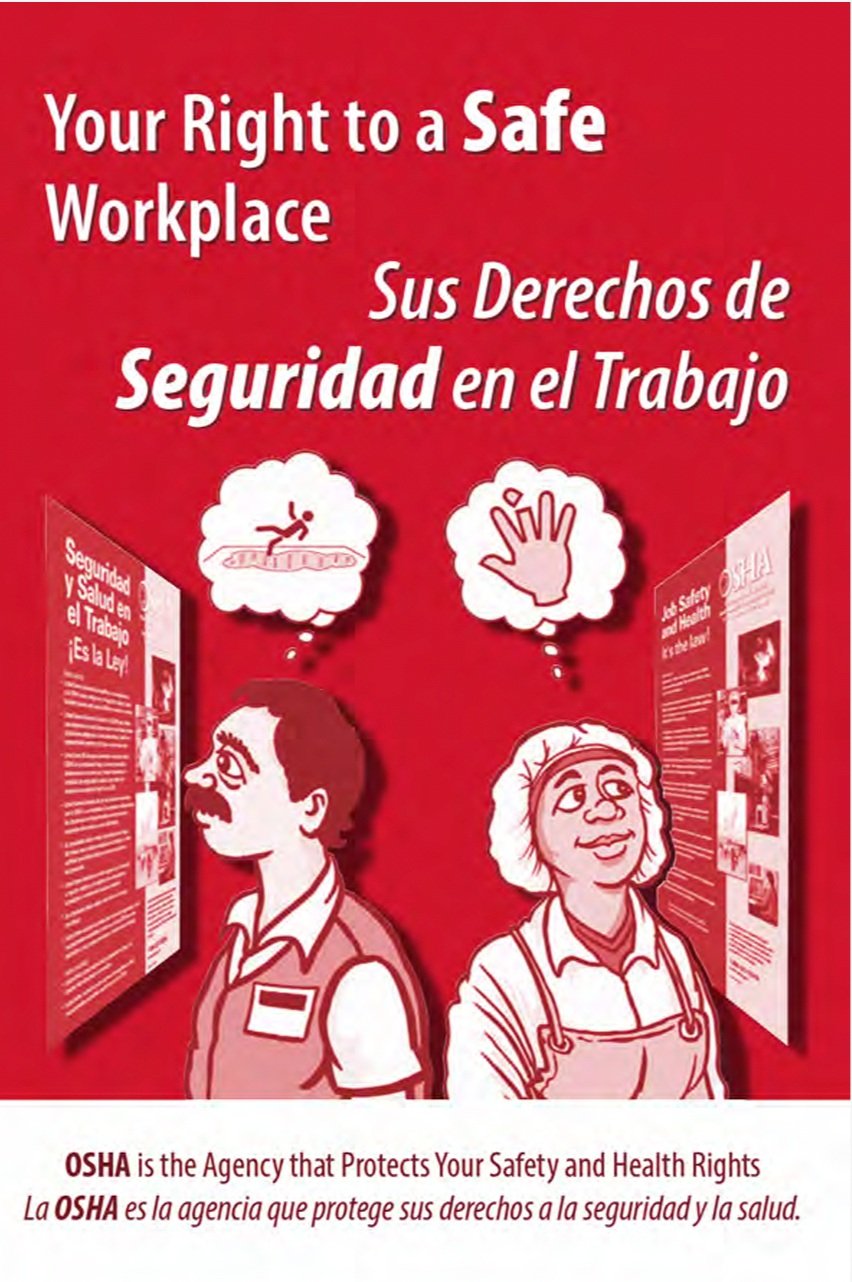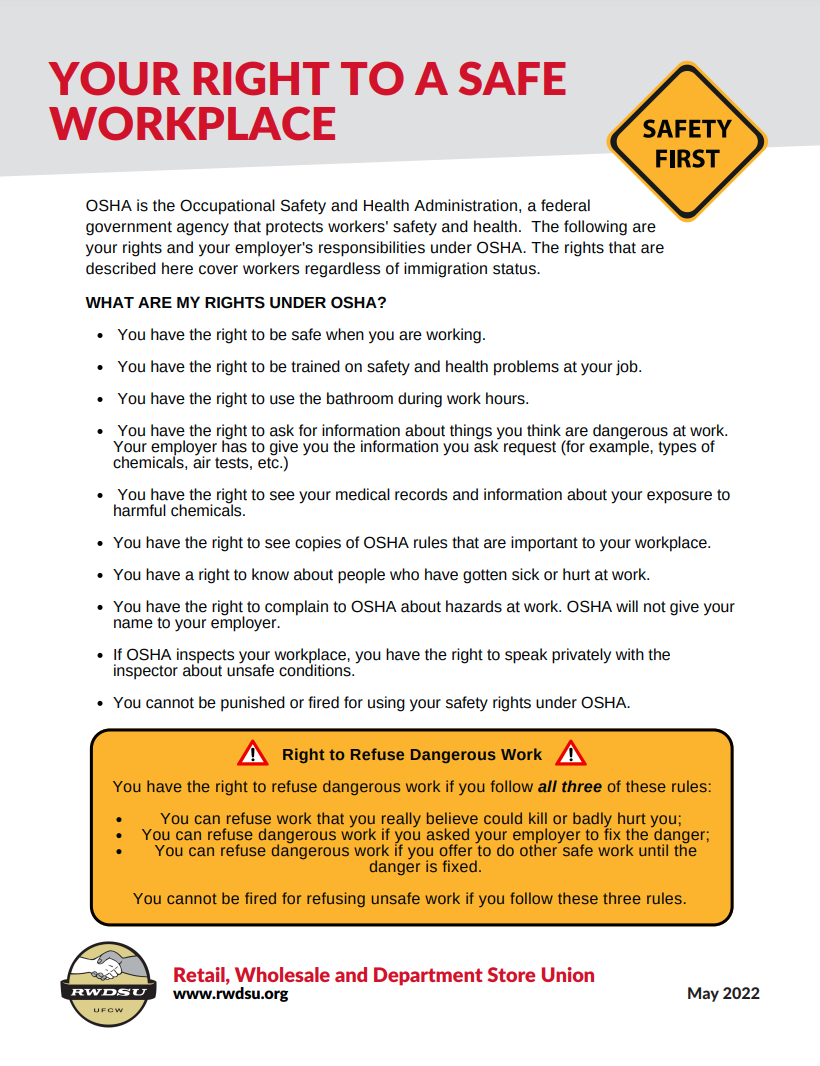
YOUR RIGHT to a Safe Workplace…
The RWDSU has a long-standing commitment to eliminate unsafe and unhealthy working conditions in all RWDSU workplaces. Unfortunately, far too many people continue to work in hazardous environments. Each year millions of workers sustain work-related injuries. Approximately 1,000 people in the U.S. die each week as a result of workplace injuries and illnesses.
The RWDSU’s health and safety program provides members with a variety of services aimed at making their workplaces safer, including training, worksite visits, and other technical assistance. Being a member of a union gives workers more options to achieve needed improvements at their workplaces. The RWDSU also actively works to influence federal and state legislation that affects the health and safety of all workers.
Knowledge about workplace health and safety issues can be the first step in helping to create better working conditions. The RWDSU Health and Safety Department helps workers understand, identify, and deal with these issues.
The Health & Safety Department can aid you and your co-workers by:
Providing assistance and resources; whether legal, educational or technical
Responding to workplace accidents
Inspecting and investigating hazards in the workplaces
Developing and implementing trainings
Views in the workplace, and the legal rights about Health, Injury and Illness:
The World Health Organization (WHO) defines Health as "a state of complete physical, mental and social well-being and not merely the absence of disease or infirmity."
In 1970, the Occupational Safety and Health Act gave legal protections to workers when exposed to hazards in the workplace. The General Duty Clause 5 (a) (1) states that “Each employer… shall furnish to each of its employees employment and a place of employment which are free from recognized hazards that are causing or are likely to cause death or serious physical harm to his employees;”
A hazard is someone, something or an environment that can cause harm.
Hazards are visible, such as uncovered electrical cables or a broken ladder. Hazards can also be invisible, such as the pressure to produce more, workplaces with not enough workers, or experiencing harassment or threats at the job.
Normalization is a process where ideas and actions come to be seen as 'normal', that are 'natural' and cannot be changed. Sometimes our employers/co-workers will say that a hazard or getting hurt is part of the job, or that an accident was due to carelessness.
Workers that suffer injury or illness still have legal protections when and after an accident happens, and aid and support should be provided, and the collective struggle for no hazards in the workplace must continue.
Finally, we recognize that certain hazards can influence health outside of the workplace and can damage friendships, family and our wellbeing in the world as an individual and with others.
Know Your Rights
Click here for information on your rights in English & Spanish:
Resources
Health & Safety Information is changing rapidly, check back here regularly for the latest. Click on a handout or link below for more information.
The Canadian Centre for Occupational Health and Safety (CCOHS): www.ccohs.ca
Vision: the elimination of work-related illnesses and injuries. We serve Canadians - and the world - with credible and relevant tools and resources to improve workplace health and safety programs. We believe that all Canadians have a fundamental right to a healthy and safe working environment. Through our programs, services, knowledge, commitment, and action, CCOHS will continue its efforts to advance health and safety in the workplace.
Chemical Hazard and Alternative Toolbox: www.chemhat.org
ChemHAT, the Chemical Hazard and Alternatives Toolbox, is a new internet database designed to offer up easy to use information that we can use to protect ourselves, our families and our co-workers against the harm that chemicals can cause.
The Center for Construction Research and Training: www.cpwr.com
CPWR is dedicated to reducing occupational injuries, illnesses and fatalities in the construction industry. Through our research, training, and service programs, we serve the industry in cooperation with key federal and construction industry partners nationwide.
Labor Occupational Safety and Health Program (LOSH): www.losh.ucla.edu
Collaborates with workers, unions, community organizations, employers, academics, students, governmental representatives, and health professionals to improve health and safety conditions for workers in Southern California.
The National Council for Occupational Safety and Health (National COSH): www.coshnetwork.org
A federation of local and statewide "COSH" groups--Committees/Coalitions on Occupational Safety and Health. COSH groups are private, non-profit coalitions of labor unions, health and technical professionals, and others interested in promoting and advocating for worker health and safety.
The National Institute for Occupational Safety and Health (NIOSH): www.cdc.gov/niosh/topics/safety.html
Mission: To develop new knowledge in the field of occupational safety and health and to transfer that knowledge into practice.
Occupational Safety and Health Administration (OSHA): www.osha.gov
With the Occupational Safety and Health Act of 1970, Congress created the Occupational Safety and Health Administration (OSHA) to assure safe and healthful working conditions for working men and women by setting and enforcing standards and by providing training, outreach, education and assistance.
Oregon – State OSHA: http://osha.oregon.gov/Pages/index.aspx
Washington State Department of Labor and Industries: www.lni.wa.gov/Safety/default.asp
On April 7, 2020, Michael Foster gave the first interview by a poultry worker in the COVID-19 pandemic. Amid failures by the industry to give workers necessary safety protections, including basic PPE, he came forward to tell the 77-billion-dollar industry that “four-quarters” was not enough to put his life on the line. His bravery gave strength to dozens of workers whose stories collectively forced the industry to make deep and lasting health and safety changes. The strength of these workers is also winning them record wages at the bargaining table as we now call them, rightfully, essential workers.
Concerned about a health and safety issue at your facility?
Are you an RWDSU member in need of help? Let us know how we can help, send us a message and we’ll get you to the right Regional Director, Union Representative, Business Agent or Local President to help!
Interested in forming a union in your workplace to resolve some health & safety issues? Let us know what you’re experiencing and an Organizer will reach out!










